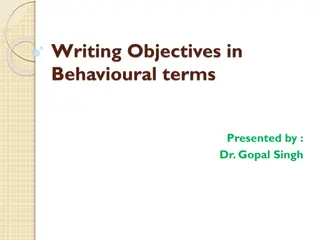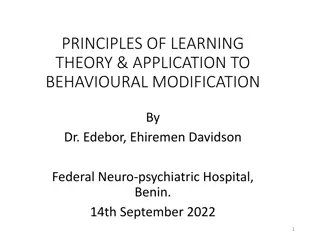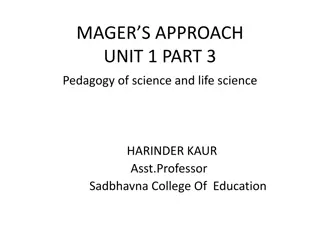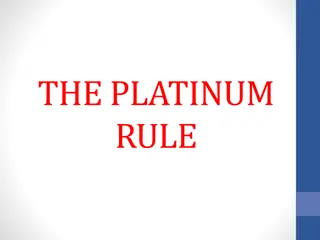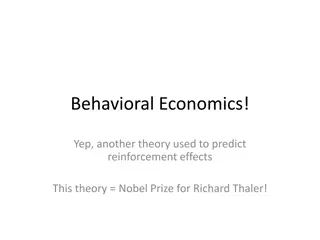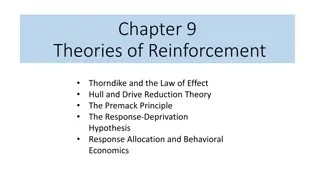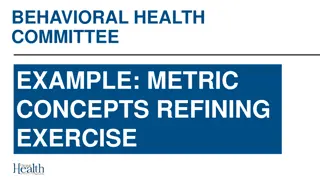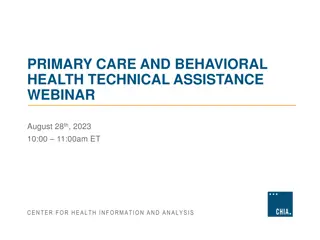Understanding Behavioral Market Efficiency
In the realm of finance, efficient markets are described by Eugene Fama as those where prices reflect all available information. However, the distinction between public and private information can be unclear. The concept of market efficiency is further expounded through the Price-equals-value and Hard-to-beat market hypotheses. Despite evidence contradicting the price-equals-value hypothesis, many investors still believe markets are easy to beat. Active investors often engage in a negative-sum game due to ignorance, cognitive and emotional errors, as well as the desire for expressive and emotional benefits. The importance of intrinsic value in investments is also highlighted, emphasizing the dividends a stock can yield, as exemplified by Warren Buffett in evaluating bond bids for Citizens Insurance.
Download Presentation

Please find below an Image/Link to download the presentation.
The content on the website is provided AS IS for your information and personal use only. It may not be sold, licensed, or shared on other websites without obtaining consent from the author. Download presentation by click this link. If you encounter any issues during the download, it is possible that the publisher has removed the file from their server.
E N D
Presentation Transcript
Finance for Normal People Chapter 11: Behavioral Market Efficiency
Behavioral Market Efficiency Efficient markets in standard finance Eugene Fama described an efficient market as one in which prices always fully reflect available information Available information, however, is an ambiguous term, and so are the terms public information and private information
Behavioral Market Efficiency The two versions of efficient markets and the two corresponding efficient market hypotheses 1. Price-equals-value markets - Markets where investments prices always equal their intrinsic values 2. Hard-to-beat markets - Markets where some investors are able to beat the market, but most are unable to do so
Behavioral Market Efficiency The price-equals-value market hypothesis is false The hard-to-beat market hypothesis is true Why do so many investors believe that markets are easy to beat?
Behavioral Market Efficiency Why do active investors continue to play a negative sum game? 1. Ignorance 2. Cognitive and emotional errors 3. Wants for expressive and emotional benefits
Behavioral Market Efficiency Intrinsic value A cow for her milk, A hen for her eggs, And a stock, by heck, for her dividends John Burr Williams, The Theory of Investment Value
Behavioral Market Efficiency Price-equals-value and hard-to-beat markets Warren Buffett received three bids from sellers of Citizens Insurance bonds, one at a price that would yield 11.33%, one at 9.87% and one at 6.00% "It's the same bond, the same time, the same dealer. And a big issue
Behavioral Market Efficiency Price-equals-value and hard-to-beat markets This is not some little anomaly, as they like to say in academic circles every time they find something that disagrees with their [efficient market] theory Buffett referred to efficient market, but the term price- equals-value market would have been more precise
Behavioral Market Efficiency Price-equals-value and hard-to-beat markets Buffett cautioned investors not to jump too fast from evidence that markets are not price-equals-value markets to the conclusion that markets are not hard-to-beat markets
Behavioral Market Efficiency Price-equals-value and hard-to-beat markets When asked What advice would you give to someone who is not a professional investor, Buffett said: Well, if they re not going to be an active investor and very few should try that then they should just stay with index funds. Any low-cost index fund They re not going to be able to pick the right price and the right time
Behavioral Market Efficiency Price-equals-value and hard-to-beat markets Investors might not care much about whether markets are price-equals-value markets But everyone should care about whether markets are price- equals-value markets Proper allocation of the economy s resources benefits everyone
Behavioral Market Efficiency The price-equals-value market hypothesis Testing the price-equals-value market hypothesis directly is difficult because estimating the intrinsic values of investments is difficult
Behavioral Market Efficiency The change-price-equals-change-value market hypothesis This hypothesis is easier to test The story of the Titanic illustrates
Behavioral Market Efficiency The change-price-equals-change-value market hypothesis Other evidence is inconsistent with this hypothesis Large changes in the level of the S&P 500 Index occurred with no events likely associated with changes in intrinsic values
Behavioral Market Efficiency Fama described an efficient market as one in which prices always fully reflect available information Available information, however, is an ambiguous term, and so are the terms public information and private information Publication in Nature make information publicly available, and so does publication in the New York Times Yet publication in the New York Times makes information widely available whereas publication in Nature, makes it only narrowly available
Behavioral Market Efficiency Eugene Fama divided the efficient market hypothesis into three forms: 1. The strong form 2. The semi-strong form 3. The weak form
Behavioral Market Efficiency The three forms of the hard-to-beat market hypothesis 1. The exclusively-available-information form 2. The narrowly-available-information form 3. The widely-available-information form
Behavioral Market Efficiency Who beats a hard-to-beat market? Hard-to-beat markets are not impossible to beat Investors with exclusively-available information find it easy to beat the market Investors with narrowly-available information find it hard but not impossible to beat the market Yet, on average, investors with nothing more than widely- available information find it impossible to beat the market
Behavioral Market Efficiency Why do investors with only widely-available information try to beat the market? Think of a stock market game as a tennis game You profit by $100 if you do not play You profit by $150 if you play and win You profit by $50 if you play and lose Would you play?
Behavioral Market Efficiency Why do investors with only widely-available information try to beat the market? Match-the-market investors choose not to play Divide beat-the-market players into two kinds, amateurs and professionals Professionals win half the games when facing professionals, collecting $100 on average in each game Professionals always win when facing amateurs, collecting $150 Professionals collect $125 on average in each game
Behavioral Market Efficiency Why do investors with only widely-available information try to beat the market? Amateurs win half the games when facing amateurs, collecting $100 on average in each game They lose all games when facing professionals, collecting $50 in each game Amateurs collect $75 on average in each game
Behavioral Market Efficiency Fischer Black described the trading puzzle in Noise. A person with information or insights about individual firms will want to trade, but will realize that only another person with information or insights will take the other side of the trade Taking the other side's information into account, is it still worth trading? From the point of view of someone who knows what both the traders know, one side or the other must be making a mistake If the one who is making a mistake declines to trade, there will be no trading on information
Behavioral Market Efficiency Noise trading, wrote Black, is the key to solving the trading puzzle Some noise traders are motivated to trade by ignorance about their cognitive and emotional errors - Perhaps they think the noise they are trading on is information Other noise traders are motivated to trade by wants - Or perhaps they just like to trade
Behavioral Market Efficiency Why do investors with only widely-available information try to beat the market? Framing errors Framing trading as tennis played against a training wall Overplacement errors Can you really beat Djokovic? Availability errors Winners are more available to memory Representativeness errors - focusing on their own recent returns and neglecting to consider the average returns of all investors over long time periods
Behavioral Market Efficiency Wants affect behavior even in the absence of cognitive and emotional errors A Fidelity survey found that 78% of traders trade for reasons beyond profits; 54% enjoy the thrill of the hunt, 53% enjoy learning new investment skills, More than half enjoy engaging in social activities
Behavioral Market Efficiency Money managers cater to investors wants and exploit their cognitive and emotional errors Managers of beat-the-market funds satisfy their investors wants for the utilitarian benefits of high returns and the expressive and emotional benefits of playing the beat-the-market game and winning
Behavioral Market Efficiency Mutual fund managers exploit availability errors by window dressing, changing the composition of their portfolios to increase their appeal when disclosed to investors
Behavioral Market Efficiency Making the market hard to beat by beating it We face what seems like a paradox: Investors who believe that the hard-to-beat market hypothesis is false can make the hard-to-beat market hypothesis come true Indeed, they can even make the price-equals-value market hypothesis come true.
Index of Price-Equals- Value Market Efficiency 100 90 0 0 Aggregate Effort to Beat the Market Equilibrium Aggregate Effort
Index of Price-Equals-Value Market Efficiency 100 90 70 Markets with high costs Markets with low costs 0 Equilibrium Aggregate Effort in Markets with Low Cost Equilibrium Aggregate Effort in Markets with High Cost Aggregate Effort to Beat the Market
Index of Price-Efforts- Value Market Efficiency 100 0 Aggregate Effort to Beat the Market
Behavioral Market Efficiency Bubbles in rational and hard-to-beat markets Bubbles cannot exist in price-equals-value markets Bubbles, however, can persist in hard-to-beat markets
Percentage of investors who think now is a good Correlation = 0.49 75 time to invest in the financial markets 65 55 45 10 20 30 40 50 Percentage of investors who think the stock market is overvalued
50 45 40 35 P/E (CAPE) Ratio 30 25 20 15 10 5 0 1926 1936 1946 1956 1966 1976 1986 1996 2006
Correlation = 0.71 25.0% Annualized return in the subsequent 20.0% 15.0% 10-years 10.0% 5.0% 0.0% -5.0% -10.0% 0 10 P/E ratio (CAPE) in December of a year 20 30 40 50
CAPE Ratios 35 10.23% 30 10.31% 25 10.29% 22 10.61% 20 10.19% 18 9.25% Median = 16.21 9.18% 14 8.45% 12 7.73% 10 4.89% Stock Buy and Hold 10.02% 0.00% 2.00% 4.00% Annuailzed 10-Year Return 6.00% 8.00% 10.00% 12.00%
Behavioral Market Efficiency The joint hypothesis: Market efficiency, asset pricing, and smart beta The efficient market hypothesis cannot be tested on its own Returns of small-capitalization and value stocks when measured by the CAPM might indicate that the market is not efficient Or they might indicate that the CAPM is a faulty model of expected returns
Behavioral Market Efficiency Smart beta strategies center on portfolios whose allocations do not correspond to market capitalizations The proportion of a particular value stock might be 0.5% by market capitalization But the proportion allocated to this value stock might be 2% in a smart beta portfolio Are excess returns of smart beta strategies evidence that markets are not efficient? Or are they reflections of faulty asset pricing models?
Behavioral Market Efficiency Jennifer Bender of State Street Global Investors said: For smart beta, the end investor makes a decision to have exposure to certain factors This is very different from, say, a traditional quantitative manager who would use factors to generate [market-beating] alpha [Q]uite a bit of active returns can be explained by very simple rules- based factor portfolios And that does present a challenge to active investing overall!
Behavioral efficient markets What is the joint hypothesis? You have the file Factors-Students from Chapter 10, and you calculated regressions of each of 4 mutual fund by the CAPM, 3-factor, and 5-factor asset pricing models. The alpha of each fund by each asset pricing model is its excess returns. (The estimated alpha of each fund by each asset pricing model is the intercept of the regression) Look at the alphas of each fund by each of the asset pricing models. Are the alphas of each fund the same by the 3 models or are they different? What do the alphas tell us about market efficiency? How do they illustrate the joint hypothesis?
Behavioral asset pricing Question Excel file factors-Students includes monthly factor returns of 5 factors, market, small-large, value-growth, profitability, and investment. Factor returns are returns minus Treasury-bill returns that proxy for the risk free returns. It also includes monthly returns minus Treasury-bill returns of four mutual funds: VISGX - Vanguard Small Capitalization Growth Index Fund VISVX - Vanguard Small Capitalization Value Index Fund VUVLX - Vanguard US Value VIGRX - Vanguard Growth Index Fund
Behavioral asset pricing 5 Factors Mkt-RF is the return on a portfolio of all US stocks minus the return on Treasury bills SMB (Small Minus Big) is the return on a small stock portfolio (small market capitalization) minus the return on big stock portfolio (large market capitalization HML (High Minus Low) is the return on a value portfolio (high ratio of book to market) minus the return on a growth portfolio (low ratio of book to market) RMW (Robust Minus Weak) is the return on a robust operating profitability portfolio minus the return on a weak operating profitability portfolio CMA (Conservative Minus Aggressive) is the return on a conservative investment portfolio minus the return on an aggressive investment portfolio
Behavioral asset pricing Examine the returns minus Treasury-bill returns of each mutual fund by the CAPM, 3-factor model, and 5-factor model What are the betas of each factor according to each model? How do you interpret the betas? Are the betas consistent with the names of the funds? How are the betas similar or different across the 3 models?
Behavioral asset pricing VISGX- RF VISVX- RF VUVLX- RF VIGRX- RF Mkt-RF SMB HML RMW CMA RF 200605 -3.57 -3.01 2.79 0.6 1.32 0.43 -6.39 -4.26 -3.48 -3.99 200606 -0.35 -0.38 1.49 1.05 -0.06 0.4 -1.20 0.69 -0.62 -0.76 200607 -0.78 -3.64 3.42 1.72 0.96 0.4 -5.70 -1.86 0.70 -2.42 200608 2.03 0.44 -1.78 -1.82 2.14 0.42 1.77 1.90 2.26 2.58 200609 1.84 -1.35 -0.5 1.63 0.53 0.41 0.48 0.47 2.20 2.43 200610 3.23 1.87 0.52 -0.95 0.23 0.41 5.25 4.41 2.20 3.03 200611 1.71 0.77 0.53 -0.16 -0.85 0.42 2.71 2.62 0.32 1.77
Behavioral asset pricing VISGX - Vanguard Small Capitalization Growth Index Fund VISGX-RF CAPM Coefficients t Stat P-value Intercept -0.07 -0.42 0.68 Mkt-RF 1.23 31.47 0.00
Behavioral asset pricing VISGX is a small growth fund Based on the CAPM (1-factor model) it has a market-factor beta of 1.23 So when the return of the stock market increases by 1 percentage point, the return of VISGX can be expected to increase by 1.23 percentage points
Behavioral asset pricing VISGX - Vanguard Small Capitalization Growth Index Fund 3-Factor Model Coefficients t Stat P-value Intercept -0.03 -0.37 0.71 Mkt-RF 1.09 50.37 0.00 SMB 0.78 18.87 0.00 HML -0.25 -6.46 0.00
Behavioral asset pricing VISGX is a small growth fund Based on the 3-factor model, it tilts toward small capitalization stocks and away from large capitalization stocks (Its Small-Large (SMB) beta is positive 0.78) It tilts away from value stocks and toward growth stocks (Its Value-Growth (HML) beta is negative -0.25)
Behavioral asset pricing VISGX - Vanguard Small Capitalization Growth Index Fund 5-Factor Model Coefficients t Stat P-value Intercept 0.09 1.02 0.31 Mkt-RF 1.05 48.64 0.00 SMB 0.74 18.83 0.00 HML -0.16 -3.79 0.00 RMW -0.20 -3.19 0.00 CMA -0.25 -3.52 0.00









